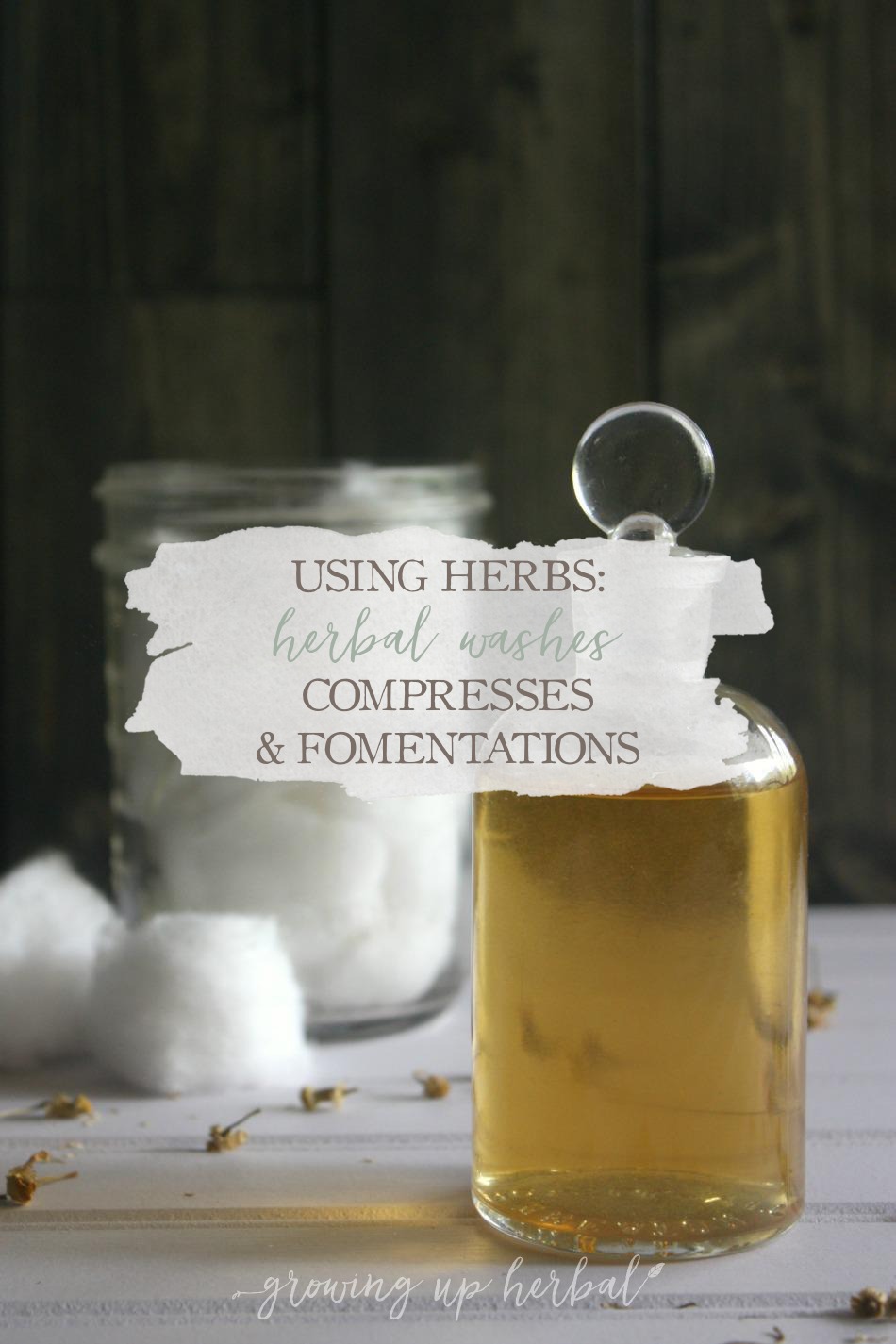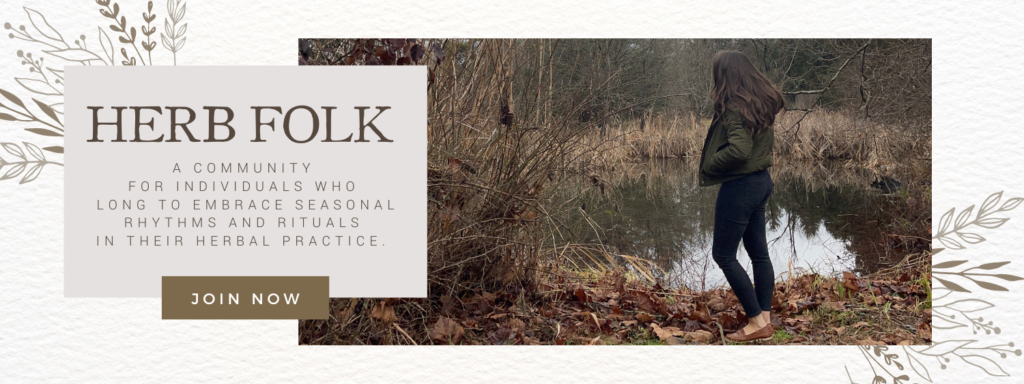
I love a good hot bath, don’t you? To me, it’s a great way to wind down from a stressful day.
Being a homeschooling mom with four little boys all under the age of 6 means I have my fair share of stressful days so a long hot bath, a good book, and glass of red wine is exactly what I need sometimes!
Speaking of baths, that brings me to today’s topic of herbal washes, compresses, and fomentations.
Last week we talked about teas, infusions, and decoctions, which are herbal preparations made with water. This week we’re going to talk about some more water-based preparations that are very similar but used in a completely different manner. Want a hint? You don’t drink these!
What Are Herbal Washes, Compresses & Fomentations, and How Do You Use Them?
Herbal washes, compresses, and fomentations are essentially herbal infusions, but instead of using them internally, you use them externally on an area of the body. This allows the constituents of the herbs to readily absorb into the skin. These preparations can be used to cleanse wounds, increase circulation, and relax sore muscles, as well as a wide range of other uses and applications.
Below we’ll look at how each one is used, how to make them, and I’ll give a few examples of each along the way as well.
Herbal Washes
Herbal washes are so easy to use, but don’t let the name “wash” fool you. They take so many forms and can be used in so many ways from wound washes to herbal baths for calming itchy rashes to soothing sinus rinses used in a neti pot to facial steams, mouthwashes, and more. Herbal washes are amazing!
To make an herbal wash, you’ll start by making an infusion or decoction with the herbs of your choice and then you will use it to rinse the skin or soak a body part, such as a hand or foot, in for a period of time.
For a wound wash, you can simply soak some gauze in your infusion and use it to gently dab or rub the wound. You can also pour the infusion over the wound to rinse it if you’d like. For a sinus rinse you’ll add some sea salt to your warm infusion and put it in a neti pot or a sinus rinse bottle. For an herbal bath, simply pour the finished infusion into the bath water.
Compress
Compresses are strong herbal infusions or decoctions that are applied externally to the body by soaking a rag in the warm infusion and placing it on the desired area of the body. They are typically used when herbs need to be applied to the area for short amounts of time, several times a day. Pink eye, colicky baby bellies, arthritic joints, or tensed neck muscles that cause headaches are some ailments where compresses are appropriate to use.
It’s best to use your infusion as warm as possible, but be careful that it’s not too hot. You don’t want to burn your child’s skin!
Fomentations
A fomentation is the same as a compress except that the rag is kept warm or cold, depending on the needs, and used over a longer period of time. Fomentations are great for pulled muscles and joint sprains as well as for nausea or diarrhea where the person can’t keep teas or any other nutrients down. By the way, don’t let the term “fomentation” confuse you. A lot of people just say “warm compress” or “cold compress”.
Points To Consider When Using Washes, Compresses, and Fomentations
Keep It Clean
Keep your preparations clean so you don’t spread germs… as in, never double-dip. Maybe that should be a hard and fast rule for life. “No double-dipping allowed!” LOL!
When using compresses and fomentations it’s wise to use a clean cloth each time you apply the solution to the body. This is especially important when you’re applying these preparations to areas of the body where spreadable bacteria and infection may be.
A great example of this would be for pink eye where compresses are applied several times a day. If your child has pink eye in one eye, you want to use a fresh cotton ball each time you dip it into the herbal infusion and apply it to the eye. If you don’t use a clean cotton ball each time you can contaminate your infusion. This is especially important if you plan on treating the uninfected eye for prevention as you don’t want to spread the bacteria to the uninfected eye.
The exception to the “no double dipping” rule is for herbal washes as they’re usually a one-time use thing. Sinus rinses, mouthwashes, and herbal baths are the kind of things that aren’t reused. Sure, you can make a large batch and store the extra in the fridge to use later, but what you’re using at the moment is used and then thrown away. When it comes to washing wounds, this too is a one-time use thing. If your kid scrapes his knee running down the driveway you can soak and clean it with an herbal wash, and you don’t have to be overly careful about using a clean cloth each time you touch the wound as there’s nothing being spread in this situation. The goal of using a wash in this way would be for cleaning the wound of debris and as much bacteria as possible.
It ultimately comes down to common sense. If you can spread bacteria, or it’s something you’re going to use over and over again — no double dipping is allowed!!
Hot Vs. Cold
I mentioned before that a fomentation could be used hot or cold. Let me explain.
WebMD.com says that heat helps to increase circulation and relax muscles while cold helps to dull pain and decrease inflammation. This can be used with fomentations depending upon what your needs are. Some examples of warm fomentations would be backaches, headaches, and earaches whereas examples of cool fomentations would be fevers, arthritic joints, and bruises.
The site also states that it can be a good idea to alternate hot and cold for things like joint sprains and muscle strains, as alternating these two temperatures helps to increase blood flow in an effort to reduce swelling and pain and promote healing of the area.
Again, it comes down to the situation and how you’re using the fomentation in the first place.
Do These Types Of External Applications Really Work Well?
This is a fair question, and one I asked myself at some point along the way. I mean, most people know that herbs are mild and they take a while to work. Most people also want results quickly, so they opt for stronger, more invasive preparations like infusions, tinctures, and capsules.
When it comes to picking and choosing to use a compress when your child has a high fever or to just buckle down and do whatever you can to get them to drink that herbal tea whether they like it or not, most parents will choose the herbal tea because they feel like that is the best preparation to help bring a fever down. Perhaps, but it isn’t your only option, and it certainly doesn’t have to be your first choice.
So to answer the above question, “Yes,” these external tea preparations do work. The reason comes down to your skin and its structure.
(Some basic skin anatomy is coming your way, but don’t worry… it won’t hurt you. Promise!)
The skin on our body consists of three layers.
- epidermis (top layer)
- dermis (middle layer)
- subcutaneous (bottom layer).
Epidermis
The top layer of skin (epidermis) is made up of row after row of cells. If you looked at these rows of cells as a 2D drawing they’d look similar to a brick wall with each cell centered between the two cells below it. I’m not sure of the exact reason why the skin’s structure is this way, as I’m sure there are many reasons, but my best guess is for strength.
The layers of the skin work to bridge the gap between the inside of the body and the outside world. It’s a pathway between internal and external. This layer controls what gets in and out, such as water, chemicals, and bacteria. It’s our first line of defense so taking good care of our skin and our children’s skin is very important.
Dermis
Just below that top layer of skin is the second layer of skin, the dermis layer. It’s in this layer where tiny blood vessels called capillaries reach up from the bigger vessels in the third layer.
The Merck Manual website states that these vessels provide nutrients and regulate body temperature. Heat makes the capillaries dilate (get bigger in diameter) and cold makes the capillaries constrict (get smaller in diameter).
It’s the relationship between this top and middle layer of skin… between the controlling epidermis and the nutrient-exchanging blood vessels of the dermis that gives us the reason why these mild, external tea preparations work well.
It’s all about absorption and chemical exchange.
When you put a lukewarm compress on your child’s head, neck, or any other body part when they have a fever and keep replacing it, it not only softens the external layer of skin allowing more of the moisture to enter, but since the body is hot, the blood vessels in the skin are dilated and release more heat at the same time. This dilation also means more blood is circulating so more nutrients and chemicals are being exchanged. This is perfect because the constituents that are transferred out of the herbs and into the water can be picked up by these tiny capillaries and transported throughout the body at this point. If you’ve chosen to use some diaphoretic herbs in your compress they can help stimulate the body to open the skin’s pores and allow the body to sweat. This process can help to lower your kiddo’s fever at a nice steady pace.
I hope that this example shows you how an external herbal preparation can work if an internal preparation can’t be used in one situation.
Hopefully, at this point, you now know the differences in herbal washes, compresses, and fomentations and how they differ from herbal teas, infusions, and decoction. I also hope you have some ideas as to how you can use these preparations as future needs arise.
So what now?
The best thing to do now is to go and make one and try it out. If you have nothing ailing you at the moment, herbal facial steams are always great!
Do you have any questions about herbal washes, compresses, or fomentations? Maybe you have a question about how they can be used. If so, I’m all ears!

Herb Folk
Herb Folk is a low-cost membership that provides exclusive monthly content centered around seasonal herbalism and lifestyle practices that educate and inspire others to slow down and let the cycles of nature guide their days. Inside you’ll find articles, videos, audio, recipes, and downloads all centered around seasonal herbalism and lifestyle. In addition to monthly seasonal herbal content, you will also find quarterly creative projects, and an exclusive community group where members can connect and learn from one another in real-time. Learn more about Herb Folk and become a member today!
Meagan, this is such an incredibly informative article! I’m pinning it to reference later on.
Your site looks amazing, by the way. Love the clean, chic feel to everything. Keep up the good work!
Thanks Kristy!! Glad you liked the post. More like it are coming!
0.5